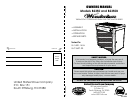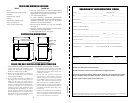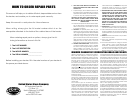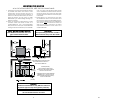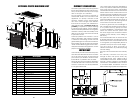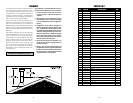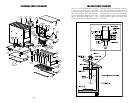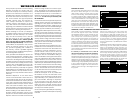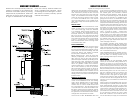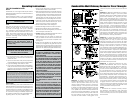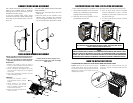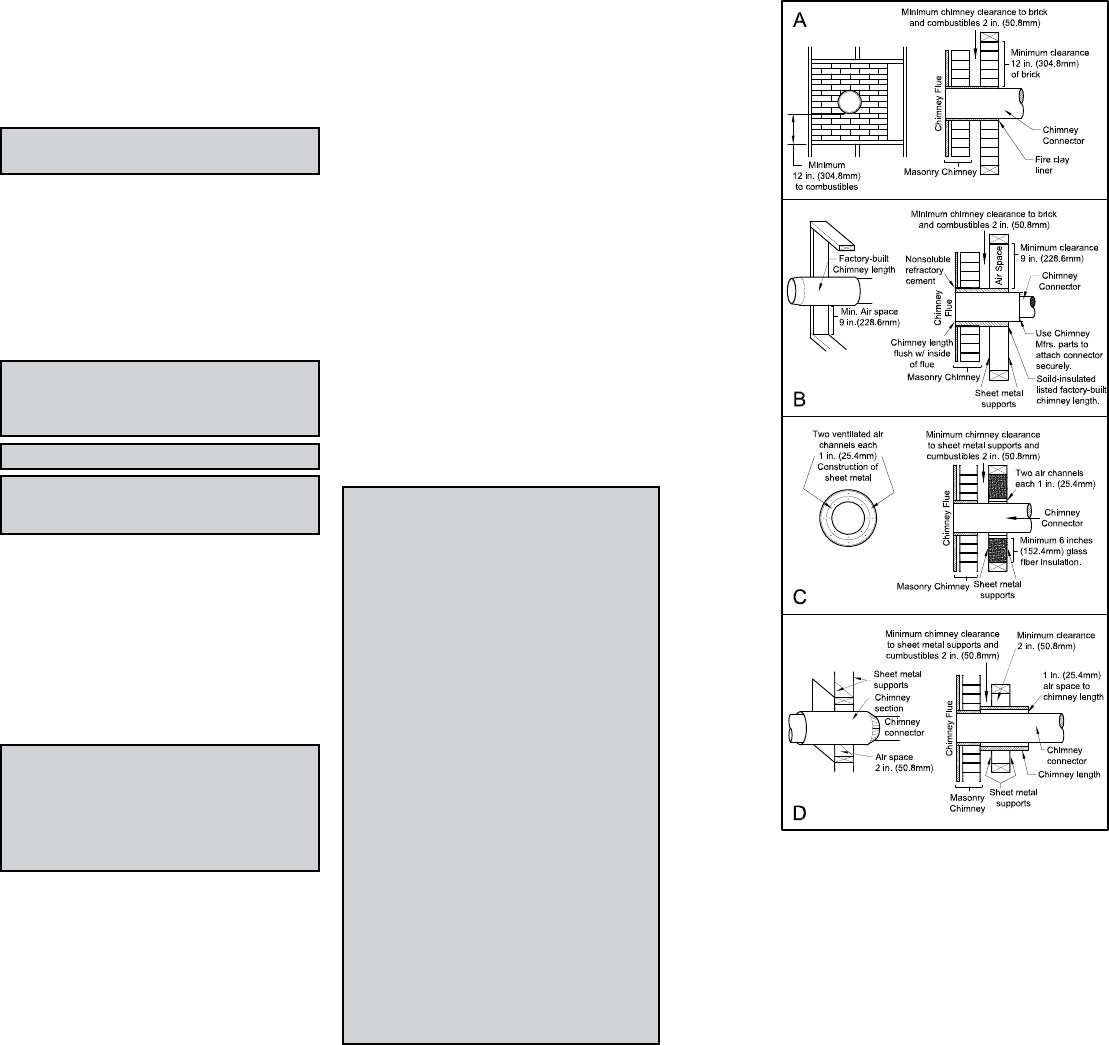
Method A. 12” (304.8 mm) Clearance to Com-
bustible Wall Member: Using a minimum thick-
ness 3.5” (89 mm) brick and a 5/8” (15.9 mm)
minimum wall thickness clay liner, construct a
wall pass-through. The clay liner must conform
to ASTM C315 (Standard Specication for Clay
Fire Linings) or its equivalent. Keep a minimum
of 12” (304.8 mm) of brick masonry between the
clay liner and wall combustibles. The clay liner
shall run from the brick masonry outer surface to
the inner surface of the chimney ue liner but
not past the inner surface. Firmly grout or ce-
ment the clay liner in place to the chimney ue
liner.
Method B. 9” (228.6 mm) Clearance to Combus-
tible Wall Member: Using a 6” (152.4 mm) inside
diameter, listed, factory-built Solid-Pak chimney
section with insulation of 1” (25.4 mm) or more,
build a wall pass-through with a minimum 9”
(228.6 mm) air space between the outer wall of
the chimney length and wall combustibles. Use
sheet metal supports fastened securely to wall
surfaces on all sides, to maintain the 9” (228.6
mm) air space. When fastening supports to
chimney length, do not penetrate the chimney
liner (the inside wall of the Solid-Pak chimney).
The inner end of the Solid-Pak chimney sec-
tion shall be ush with the inside of the masonry
chimney ue, and sealed with a non-water sol-
uble refractory cement. Use this cement to also
seal to the brick masonry penetration.
Method C. 6” (152.4 mm) Clearance to Com-
bustible Wall Member: Starting with a minimum
24 gage (.024” [.61 mm]) 6” (152.4 mm) metal
chimney connector, and a minimum 24 gage
ventilated wall thimble which has two air chan-
nels of 1” (25.4 mm) each, construct a wall pass-
through. There shall be a minimum 6” (152.4)
mm separation area containing berglass insu-
lation, from the outer surface of the wall thimble
to wall combustibles. Support the wall thimble,
and cover its opening with a 24-gage minimum
sheet metal support. Maintain the 6” (152.4 mm)
space. There should also be a support sized to
t and hold the metal chimney connector. See
that the supports are fastened securely to wall
surfaces on all sides. Make sure fasteners used
to secure the metal chimney connector do not
penetrate chimney ue liner.
Method D. 2” (50.8 mm) Clearance to Com-
bustible Wall Member: Start with a solid-pak
listed factory built chimney section at least 12”
(304 mm) long, with insulation of 1” (25.4 mm)
or more, and an inside diameter of 8” (2 inches
[51 mm] larger than the 6” [152.4 mm] chimney
connector). Use this as a pass-through for a min-
imum 24-gauge single wall steel chimney con-
nector. Keep solid-pak section concentric with
and spaced 1” (25.4 mm) off the chimney con-
nector by way of sheet metal support plates at
both ends of chimney section. Cover opening
and support chimney section on both sides with
24 gage minimum sheet metal supports. See
that the supports are fastened securely to wall
surfaces on all sides. Make sure fasteners used
do not penetrate chimney ue liner.
NOTES:
1. Connectors to a masonry chimney, except-
ing method B, shall extend in one continuous
section through the wall pass-through system
and the chimney wall, to but not past the inner
ue liner face.
FUEL RECOMMENDATIONS
WOOD
Hardwood, 18” to 23” log should be split and air
dried (seasoned) for 6 months to obtain maximum
burning efciency.
Wood should be stored in a dry, well ventilated
area. A wooden box or crate is ideal for storage.
DO NOT USE MANUFACTURED OR
CHARCOAL LOGS
COAL
Most sizes of bituminous coal will work in your
heater; for best results we recommend large
nut coal to small egg coal (1-3/4” diameter
to 4” diameter). When burning anthracite, use
egg or broken with sizes between 2-5/16” and
4-3/8”. Note that it is important to the life of your
stove to buy coal which has been sized and
cleaned. Cleaning insures removal of rocks
and other materials.
DO NOT burn coke, charcoal, high volatile
bituminous coal, sub bituminous, lignite or
cannel coal (sometimes called channel coal
or candle coal).
STORE COAL IN A DRY, WELL VENTILATED AREA.
LIGHTING
1. Set the thermostat on “HIGH” and open both
spin dampers on the feed and ash door for
maximum draft.
2. Open the feed door and place paper and
wood kindling on the grate for starting the re.
3. Light the kindling and close the door.
4. Once a re is established and burning briskly,
add your choice of fuel, wood or coal, being
careful not to smother out the kindling re. For
coal, add approximately 15 pounds.
For the rst few burns, build small res to allow
the cast iron components and painted cabinet
parts to season or cure. Your new stove will
emit some smoke and odors from the curing
process but should only do so for a short period
of time. We suggest opening a window in the
room of which the unit is installed.
CAUTION! NEVER USE THE MANUFACTURED
COAL BRICKS THAT ARE MADE FROM COAL
DUST AND A WAX TYPE BINDER.
ADDING FUEL
When maintaining a re, add small amounts of
fuel periodically as required (enough to burn for
3 to 5 hours). As you become more familiar with
the operation of your heater, it is possible to add
wood or coal to burn for longer durations of 8
to 10 hours. But during so carelessly will promote
incomplete combustion and considerable soot-
ing along with a very dirty, inefcient re.
HOT WHILE IN OPERATION. KEEP CHILDREN,
CLOTHING, FURNITURE AWAY. CONTACT MAY
CAUSE SKIN BURNS.
NEVER USE GASOLINE, GASOLINE-TYPE LANTERN
FUEL, KEROSENE, CHARCOAL LIGHTER FLUID, OR
SIMILAR LIQUIDS TO START OR “FRESHEN UP” A
FIRE IN THIS HEATER. KEEP ALL SUCH LIQUIDS
WELL AWAY FROM THE HEATER WHILE IT IS IN USE.
DO NOT OPERATE THIS HEATER WITH THE FEED
OR ASH DOOR OPEN. THIS HEATER IS DESIGNED
FOR THERMOSTATIC OPERATION. OPERATING
WITH EITHER DOOR OPEN WILL OVERHEAT AND
DAMAGE THE HEATER.
ALWAYS CLOSE THE DOORS AFTER THE IGNITION.
NEVER OVERFIRE YOUR STOVE. IF ANY PART OF
THE STOVE STARTS TO GLOW RED, OVER FIR-
ING IS HAPPENING. READjUST THE AIR INTAKE
CONTROL TO A LOWER SETTING.
BUILD FIRES DIRECTLY ON THE GRATE IN THE
HEATER.
DO NOT BURN GARBAGE, FLAMMABLE FLUID
SUCH AS GASOLINE, NAPHTHA OR MOTOR OIL.
DO NOT STORE FUEL OR OTHER COMBUSTIBLE
MATERIALS WITHIN THE MINIMUM CLEARANCES
SPECIFIED IN THIS MANUAL OR WITHIN THE SPACE
REQUIRED FOR CHARGING AND ASH REMOVAL.
DOING SO COULD RESULT IN A HOUSE FIRE.
NEVER ALTER THE ADjUSTMENT RANGE OR AIR
INLETS TO INCREASE FIRING FOR ANY REASON.
1. Always set the thermostat to high before opening
the feed door to refuel or stoke the re.
2. When opening the feed door, turn handle and open
door until it stops on the latch and leave it at that
position for at least 10 seconds before opening fully.
This, along with step 1 above, will allow any accu-
mulated gases or smoke to exit into the chimney,
eliminating ame or smoke spillage into the room.
3. If need be, shake the grate vigorously back and
forth to dump the ashes into the ash pan. Do this
at least once every 12 hours of operation.
4. Never smother the re when adding fuel.
5. Add fresh kindling if the bed of coals has cooled.
6. Never add fuel above the top of the rebrick.
7. Be sure the new fuel is burning before you close the
door and adjust combustion air.
8. Coal Fire - Refer to the Bulletine RC454 in this manual
for more information on burning coal.
9. Adjust dampers and air shutters to obtain the
burn you desire. The air shutter on the thermostat
control should never be closed complete when
burning coal.
10. Empty ash pan regularly. Do not allow the ashes
to build up to the grate as the grate will warp and
burnout will occur. Allowing ashes to build up may
also result in ash spillage when removing the ash pan.
Dispose of hot ashes properly (See Maintenance).
1114



